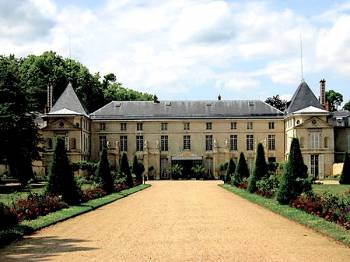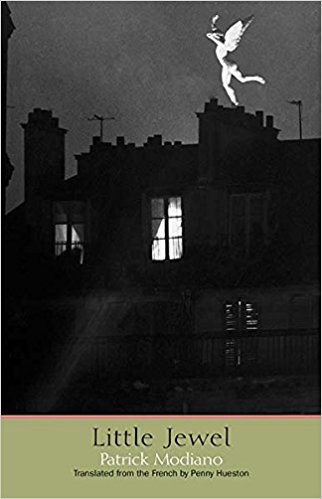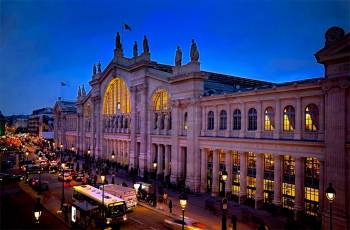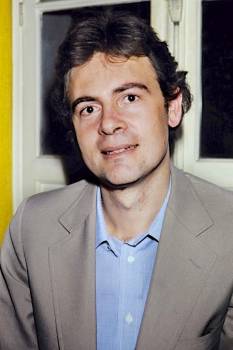Note: Patrick Modiano was WINNER of the Nobel Prize for Literature in 2014
“The Valvert School for Boys occupied the former property of a certain Valvert, who had been an intimate of the comte D’Artois and had accompanied him into exile during the Revolution. Later, as an officer in the Russian army, he fell at the Battle of Austerlitz fighting against his own countrymen in the uniform of the Izmailovsky Regiment. All that remained of him was his name and a pink marble colonnade, now half ruined, at the back of the park. My schoolmates and I were raised under that man’s morose tutelage and perhaps some of us, without realizing it, still bear the traces.”
 The image of Valvert, described above, sets the tone and establishes many of the themes for this often dream-like collection of interconnected stories, filled with mysteries and riddles. Valvert, the former owner of the property on which the Valvert School was later built, accompanied the Comte D’Artois when he abandoned France during the French Revolution, and later fought his former countrymen in France as part of a Russian regiment. At the Battle of Austerlitz, described as “the greatest victory ever achieved by Napoleon,” in 1805, he lost his life fighting for a foreign army. Clearly, revolutionary democracy was not a goal or even a consideration for Valvert. An elite friend of French royalty, he lived an elegant and privileged life, fleeing France when his life was in danger and he could no longer live there in the style he enjoyed. The building which became the school on Valvert’s property, built by a later owner at the end of the nineteenth century, was, ironically, a copy of Malmaison, the castle where Napoleon and Josephine lived during Napoleon’s war with the rest of Europe and Britain. With a history like this, it is no surprise that the Valvert School, with its Castle and its past history might appeal to parents interested in preserving the appearance, atmosphere, and values of the elite.
The image of Valvert, described above, sets the tone and establishes many of the themes for this often dream-like collection of interconnected stories, filled with mysteries and riddles. Valvert, the former owner of the property on which the Valvert School was later built, accompanied the Comte D’Artois when he abandoned France during the French Revolution, and later fought his former countrymen in France as part of a Russian regiment. At the Battle of Austerlitz, described as “the greatest victory ever achieved by Napoleon,” in 1805, he lost his life fighting for a foreign army. Clearly, revolutionary democracy was not a goal or even a consideration for Valvert. An elite friend of French royalty, he lived an elegant and privileged life, fleeing France when his life was in danger and he could no longer live there in the style he enjoyed. The building which became the school on Valvert’s property, built by a later owner at the end of the nineteenth century, was, ironically, a copy of Malmaison, the castle where Napoleon and Josephine lived during Napoleon’s war with the rest of Europe and Britain. With a history like this, it is no surprise that the Valvert School, with its Castle and its past history might appeal to parents interested in preserving the appearance, atmosphere, and values of the elite.
Nobel Prize-winner Patrick Modiano attended a boarding school that he has described as being much like this, and he saw almost nothing of either of his parents from the time he was a child until he was in his early twenties. His father, a smuggler of food and weapons from Africa and South America to the French Gestapo during the Nazi occupation, had made a fortune, and his mother, an actress often out of the country, had no time for her two sons, abandoning them to surrogates who themselves had no sense of home. For several years the boys were in the care of a group of circus performers who lived near a falling-down chateau – until the acrobats were all arrested for criminal activities. Modiano has spent his adult life since then recreating his childhood and teen years in his novels and asking questions. Had it not been for author Raymond Queneau, who taught him geometry when he was in secondary school, and then became his only real mentor, he might never have become the writer he is. Queneau introduced him to the literary world, where he felt at home for the first time, and Modiano responded by winning prizes for his first three novels, starting at age twenty-three. Since then he has written over thirty more novels and has won the Nobel Prize for Literature.

Built on property that once belonged to Valvert, the Castle was built by a later owner as a copy of Malmaison, where Napoleon and Josephine lived in the early 19th century.
This book, published originally in France in 1982 and translated into English by Mark Polizzotti for Yale’s Margellos Collection this year, will answer many questions for fans of Modiano in the English-speaking world. Most of his previous novels have focused on various aspects of his early life, but this is the first book I have read which deals with those crucial teenage years and immediately after, leading eventually to his first novel. Here in fourteen interrelated chapters, told by more than one narrator, including one named “Patrick,” he tells the stories of ten fellow students during boarding school or in later life, illustrating that as a group, the students’ lack of a loving home, combined with the absence of real nurturing by their teachers, have left them with conflicted memories and no true sense of identity. Their lack of deeply held values often leaves them unable to make thoughtful decisions, and most of these former students do not recognize that other people may see life through a completely different lens. As the narrators tell their stories, it becomes clear that each narrator, too, has difficulty understanding these characters and their reactions to the circumstances in which they find themselves – that the narrators, too, may be ill-equipped to understand how and why these characters have become who they are. No one here is always who he seems to be, and at several points in the book, a narrator suddenly develops a different name and may or may not be a different person.

The labyrinth at the Castle, off limits to students, was a quiet place where the faculty could escape.
The narrator of Chapter II introduces Edmond Claude, who is an actor. Both the narrator and Claude are former students who have recently seen Lafaure, their former chemistry teacher. As Edmond tells about Lafaure coming to see him in his tiny role at a small theatre, years after he has graduated, Edmond also keeps his make-up on, showing himself to be someone whose identity cannot be taken at “face” value. Another student, Daniel Desoto, who was expelled, comes back to the school later in a red sports car and lets people know that his father recently bought him a sailboat. Later Desoto marries and becomes as indebted, emotionally, to his wife and her “doctor” as he is to his father, whose extravagant gifts have taken the place of true love and support. Robert McFowles, a former athlete at the school, has inherited all his grandmother’s shares in a large cosmetics company, but he obsesses about how much he misses the sea, even doing pretend dives into his lawn. The narrator describes him as a “sensitive, guileless boy who was looking for stability…and [like others from Valvert] prone to inexplicable bouts of melancholy [and] waves of sadness,” helpless in the real world.

Modiano wrote a novel about Little Jewel in 2001. It was translated and published in English by Yale University Press in 2016.
Another alumnus visits the school once each month when the school shows films, since it always repeats a film about “Little Jewel.” The narrator of this story has attended a course in “show business” where a wealthy woman claiming to be twenty-three years old has won all the prizes. Her daughter Martine (Little Jewel) is ignored until this woman hires one of the young actors to be Jewel’s devoted babysitter, finally providing her with a sense that someone cares. Later, without warning, the mother decides to make little Jewel into an actress – it is easier for her than accepting responsibility. Though determining who is the narrator is difficult in this chapter, Little Jewel eventually becomes the subject of an entire book by Modiano in 2001. Additional Valvert alumni feature in other stories, and in one, a narrator named Patrick looks to rent an apartment for a friend and learns that the owner, a woman he recognizes, was a circus acrobat. The ending of the novel brings the fate of the school up to date. Its wealthy, but lost and naïve teenage students have become equally lost and purposeless adults, and their lack of home, family love, and someone to serve as a model for them makes it unlikely that any of them besides Patrick Modiano, perhaps, will ever experience a sense of peace or fulfillmen
NOTE: Readers new to Modiano who are looking for a book which will provide the greatest information about his background and a good introduction to his style may want to begin with SUSPENDED SENTENCES.
ALSO by Modiano: AFTER THE CIRCUS, DORA BRUDER, FAMILY RECORD, HONEYMOON, IN THE CAFE OF LOST YOUTH, LA PLACE de L’ETOILE (Book 1 of the OCCUPATION TRILOGY), (with Louis Malle–LACOMBE LUCIEN, a screenplay, LITTLE JEWEL, THE NIGHT WATCH (Book II of the OCCUPATION TRILOGY), THE OCCUPATION TRILOGY (LA PLACE DE L’ETOILE, THE NIGHT WATCH, AND RING ROADS), PARIS NOCTURNE, PEDIGREE: A Memoir, RING ROADS (Book III of the OCCUPATION TRILOGY), SLEEP OF MEMORY, SO YOU DON’T GET LOST IN THE NEIGHBORHOOD, SUNDAYS IN AUGUST, SUSPENDED SENTENCES, VILLA TRISTE, YOUNG ONCE
Post-Nobel Prize books: SLEEP OF MEMORY (2017), INVISIBLE INK (2019)

Several of Modiano’s characters make a number of trips to and from the Gard du Nord, regarding it as a symbol of escape.
Photos: The author’s photo appears on http://www.lemonde.fr
Malmaison, home of Napoleon and Josephine in the early 1800’s was the model for the Castle building at Valvert School. https://trudon.com/
Valvert had a labyrinth, off-limits to students, which was enjoyed by the faculty as a place to relax. This particular labyrinth is in the VanDusen Botanical Gardens in Vancouver, British Columbia. http://wikimapia.org/
Little Jewel was the subject of a book by the same name, published in France in 2001 and in English by the Margellos Collection of Yale University in 2016. http://yalebooks.yale.edu/
The Gare du Nord appears on https://www.kyriad.com/

